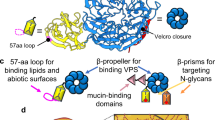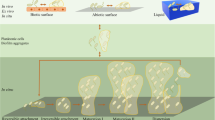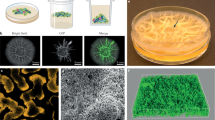Abstract
Microbes attach to surfaces and form dense communities known as biofilms, which are central to how microbes live and influence humans. The key defining feature of biofilms is adhesion, whereby cells attach to one another and to surfaces, via attachment factors and extracellular polymers. While adhesion is known to be important for the initial stages of biofilm formation, its function within biofilm communities has not been studied. Here we utilise an individual-based model of microbial groups to study the evolution of adhesion. While adhering to a surface can enable cells to remain in a biofilm, consideration of within-biofilm competition reveals a potential cost to adhesion: immobility. Highly adhesive cells that are resistant to movement face being buried and starved at the base of the biofilm. However, we find that when growth occurs at the base of a biofilm, adhesion allows cells to capture substratum territory and force less adhesive, competing cells out of the system. This process may be particularly important when cells grow on a host epithelial surface. We test the predictions of our model using the enteric pathogen Vibrio cholerae, which produces an extracellular matrix important for biofilm formation. Flow cell experiments indicate that matrix-secreting cells are highly adhesive and form expanding clusters that remove non-secreting cells from the population, as predicted by our simulations. Our study shows how simple physical properties, such as adhesion, can be critical to understanding evolution and competition within microbial communities.
Similar content being viewed by others
Log in or create a free account to read this content
Gain free access to this article, as well as selected content from this journal and more on nature.com
or
References
Absalon C, Van Dellen K, Watnick PI . (2011). A communal bacterial adhesin anchors biofilm and bystander cells to surfaces. PLoS Pathog 7: e1002210.
Ai H-W, Henderson JN, Remington SJ, Campbell RE . (2006). Directed evolution of a monomeric, bright and photostable version of Clavularia cyan fluorescent protein: structural characterization and applications in fluorescence imaging. Biochem J 400: 531–540.
Alam M, Sultana M, Nair G . (2006). Toxigenic Vibrio cholerae in the aquatic environment of Mathbaria, Bangladesh. Appl Environ Microbiol 72: 2849–2855.
Bevins CL, Salzman NH . (2011). The potter’s wheel: the host’s role in sculpting its microbiota. Cell Mol Life Sci 68: 3675–3685.
Böckelmann U, Szewzyk U, Grohmann E . (2003). A new enzymatic method for the detachment of particle associated soil bacteria. J Microbiol Methods 55: 201–211.
Boles BR, Thoendel M, Singh PK . (2004). Self-generated diversity produces ‘insurance effects’ in biofilm communities. Proc Natl Acad Sci USA 101: 16630–16635.
Boris S, Suárez JE, Vázquez F, Barbés C . (1998). Adherence of human vaginal lactobacilli to vaginal epithelial cells and interaction with uropathogens. Infect Immun 66: 1985–1989.
Carter MQ, Brandl MT, Louie JW, Kyle JL, Carychao DK, Cooley MB et al. (2011). Distinct acid resistance and survival fitness displayed by Curli variants of enterohemorrhagic Escherichia coli O157:H7. Appl Environ Microbiol 77: 3685–3695.
Cash HL, Whitham CV, Behrendt CL, Hooper LV . (2006). Symbiotic bacteria direct expression of an intestinal bactericidal lectin. Science 80: 313–1126.
Chattopadhyay S, Tchesnokova V, McVeigh A, Kisiela DI, Dori K, Navarro A et al. (2012). Adaptive evolution of class 5 fimbrial genes in enterotoxigenic Escherichia coli and its functional consequences. J Biol Chem 287: 6150–6158.
Church D, Elsayed S, Reid O, Winston B, Lindsay R . (2006). Burn wound infections. Clin Microbiol Rev 19: 403–434.
Conrady DG, Wilson JJ, Herr AB . (2013). Structural basis for Zn 2+-dependent intercellular adhesion in staphylococcal biofilms. Proc Natl Acad Sci USA 110: E202–E211.
Cordero OX, Ventouras L-A, DeLong EF, Polz MF . (2012). Public good dynamics drive evolution of iron acquisition strategies in natural bacterioplankton populations. Proc Natl Acad Sci USA 109: 20059–20064.
Crociani J, Grill JP, Huppert M, Ballongue J . (1995). Adhesion of different bifidobacteria strains to human enterocyte-like Caco-2 cells and comparison with in vivo study. Lett Appl Microbiol 21: 146–148.
Derrien M, van Passel MW, van de Bovenkamp JH, Schipper RG, de Vos WM, Dekker J . (2010). Mucin-bacterial interactions in the human oral cavity and digestive tract. Gut Microbes 1: 254–268.
Dranginis AM, Rauceo JM, Coronado JE, Lipke PN . (2007). A biochemical guide to yeast adhesins: glycoproteins for social and antisocial occasions. Microbiol Mol Biol Rev 71: 282–294.
Drescher K, Nadell CD, Stone HA, Wingreen NS, Bassler BL . (2014). Solutions to the public goods dilemma in bacterial biofilms. Curr Biol 24: 50–55.
Garcia MC, Lee JT, Ramsook CB, Alsteens D, Dufrêne YF, Lipke PN . (2011). A role for amyloid in cell aggregation and biofilm formation. PLoS One 6: e17632.
Hallatschek O, Hersen P, Ramanathan S, Nelson DR . (2007). Genetic drift at expanding frontiers promotes gene segregation. Proc Natl Acad Sci USA 104: 19926–19930.
Hall-Stoodley L, Costerton JW, Stoodley P . (2004). Bacterial biofilms: from the natural environment to infectious diseases. Nat Rev Microbiol 2: 95–108.
Halme A, Bumgarner S, Styles C, Fink GR . (2004). Genetic and epigenetic regulation of the FLO gene family generates cell-surface variation in yeast. Cell 116: 405–415.
Heilmann C, Schweitzer O, Gerke C, Vanittanakom N, Mack D, Götz F . (1996). Molecular basis of intercellular adhesion in the biofilm-forming Staphylococcus epidermidis. Mol Microbiol 20: 1083–1091.
Hooper LV, Xu J, Falk PG, Midtvedt T, Gordon JI . (1999). A molecular sensor that allows a gut commensal to control its nutrient foundation in a competitive ecosystem. Proc Natl Acad Sci USA 96: 9833–9838.
Huq A, Small EB, West PA, Huq MI, Rahman R, Colwell RR . (1983). Ecological relationships between Vibrio cholerae and planktonic crustacean copepods. Appl Environ Microbiol 45: 275–283.
Kim W, Racimo F, Schluter J, Levy SB, Foster KR . (2014). Importance of positioning for microbial evolution. Proc Natl Acad Sci USA 111: E1639–E1647.
Kreft JU, Picioreanu C, Wimpenny JW, van Loosdrecht MC . (2001). Individual-based modelling of biofilms. Microbiology 147: 2897–2912.
Linke D, Riess T, Autenrieth IB, Lupas A, Kempf VAJ . (2006). Trimeric autotransporter adhesins: variable structure, common function. Trends Microbiol 14: 264–270.
Liu CH, Lee SM, Vanlare JM, Kasper DL, Mazmanian SK . (2008). Regulation of surface architecture by symbiotic bacteria mediates host colonization. Proc Natl Acad Sci USA 105: 3951–3956.
Ma L, Jackson KD, Landry RM, Parsek MR, Wozniak DJ . (2006). Analysis of Pseudomonas aeruginosa conditional psl variants reveals roles for the psl polysaccharide in adhesion and maintaining biofilm structure postattachment. J Bacteriol 188: 8213–8221.
MacKenzie DA, Tailford LE, Hemmings AM, Juge N . (2009). Crystal structure of a mucus-binding protein repeat reveals an unexpected functional immunoglobulin binding activity. J Biol Chem 284: 32444–32453.
Macklaim J, Gloor G, Anukam K, Cribby S, Reid G . (2011). At the crossroads of vaginal health and disease, the genome sequence of Lactobacillus iners AB-1. Proc Natl Acad Sci USA 108: 4688–4695.
Malik S, Petrova MI, Claes IJJ, Verhoeven TLA, Busschaert P, Vaneechoutte M et al. (2013). The high auto-aggregative and adhesive phenotype of the vaginal Lactobacillus plantarum strain CMPG5300 is sortase-dependent. Appl Environ Microb 79: 4576–4585.
Meibom KL, Li XB, Nielsen AT, Wu C-Y, Roseman S, Schoolnik GK . (2004). The Vibrio cholerae chitin utilization program. Proc Natl Acad Sci USA 101: 2524–2529.
Mitri S, Foster KR . (2013). The genotypic view of social interactions in microbial communities. Annu Rev Genet 47: 247–273.
Mitri S, Xavier JB, Foster KR . (2011). Social evolution in multispecies biofilms. Proc Natl Acad Sci USA 108: 10839–10846.
Nadell CD, Bassler BL . (2011). A fitness trade-off between local competition and dispersal in Vibrio cholerae biofilms. Proc Natl Acad Sci USA 108: 14181–14185.
Nadell CD, Foster KR, Xavier JB . (2010). Emergence of spatial structure in cell groups and the evolution of cooperation. PLoS Comput Biol 6: e1000716.
Nadell CD, Xavier JB, Levin SA, Foster KR . (2008). The evolution of quorum sensing in bacterial biofilms. PLoS Biol 6: e14.
Nalin DR, Daya V, Reid a, Levine MM, Cisneros L . (1979). Adsorption and growth of Vibrio cholerae on chitin. Infect Immun 25: 768–770.
O’Toole G, Kaplan H, Kolter R . (2000). Biofilm formation as microbial development. Annu Rev Microbiol 54: 49–79.
Petrova OE, Sauer K . (2012). Sticky situations: key components that control bacterial surface attachment. J Bacteriol 194: 2413–2425.
Picioreanu C, van Loosdrecht MC, Heijnen JJ . (1998). Mathematical modeling of biofilm structure with a hybrid differential-discrete cellular automaton approach. Biotechnol Bioeng 58: 101–116.
Picioreanu C, van Loosdrecht MCM, Heijnen JJ . (1997). Modelling the effect of oxygen concentration on nitrite accumulation in a biofilm airlift suspension reactor. Water Sci Tech 36: 147–156.
Pradhan AK, Pradhan N, Sukla LB, Panda PK, Mishra BK . (2014). Inhibition of pathogenic bacterial biofilm by biosurfactant produced by Lysinibacillus fusiformis S9. Bioprocess Biosyst Eng 37: 139–149.
Queller DC, Ponte E, Bozzaro S, Strassmann JE . (2003). Single-gene greenbeard effects in the social amoeba Dictyostelium discoideum. Science 299: 105–106.
Romero D, Aguilar C, Losick R, Kolter R . (2010). Amyloid fibers provide structural integrity to Bacillus subtilis biofilms. Proc Natl Acad Sci USA 107: 2230–2234.
Sachs JL . (2008). Resolving the first steps to multicellularity. Trends Ecol Evol 23: 245–248.
Sauer K, Camper AK, Ehrlich GD, William J, Davies DG, Costerton JW . (2002). Pseudomonas aeruginosa displays multiple phenotypes during development as a biofilm. J Bacteriol 184: 1140–1154.
Schluter J, Foster KR . (2012). The evolution of mutualism in gut microbiota via host epithelial selection. PLoS Biol 10: e1001424.
Shahid S, Markovic S, Linke D, Rossum B van. (2012a). Assignment and secondary structure of the YadA membrane protein by solid-state MAS NMR. Sci Rep 2: 803.
Shahid SA, Bardiaux B, Franks WT, Krabben L, Habeck M, van Rossum B-J et al. (2012b). Membrane-protein structure determination by solid-state NMR spectroscopy of microcrystals. Nat Methods 9: 1212–1217.
Shapiro BJ, Friedman J, Cordero OX, Preheim SP, Timberlake SC, Szabo G et al. (2012). Population genomics of early events in the ecological differentiation of bacteria. Science 336: 48–51.
Shcherbo D, Merzlyak EM, Chepurnykh TV, Fradkov AF, Ermakova GV, Solovieva EA et al. (2007). Bright far-red fluorescent protein for whole-body imaging. Nat Methods 4: 741–746.
Smukalla S, Caldara M, Pochet N, Beauvais A, Guadagnini S, Yan C et al. (2008). FLO1 is a variable green beard gene that drives biofilm-like cooperation in budding yeast. Cell 135: 726–737.
Stewart PS, Franklin MJ . (2008). Physiological heterogeneity in biofilms. Nat Rev Microbiol 6: 199–210.
Sutherland IW . (2001). Biofilm exopolysaccharides: a strong and sticky framework. Microbiology 147: 3–9.
Timmerman CP, Fleer A, Besnier JM, De Graaf L, Cremers F, Verhoef J . (1991). Characterization of a proteinaceous adhesin of Staphylococcus epidermidis which mediates attachment to polystyrene. Infect Immun 59: 4187–4192.
Tojo M, Yamashita N, Goldmann DA, Pier GB . (1988). Isolation and Characterization of a Capsular Polysaccharide Adhesin from Staphylococcus epidermidis. J Infect Dis 157: 713–722.
Veenstra G, Cremers F, van Dijk H, Fleer A . (1996). Ultrastructural organization and regulation of a biomaterial adhesin of Staphylococcus epidermidis. J Bacteriol 178: 537–541.
Vidal O, Longin R, Prigent-Combaret C, Dorel C, Hooreman M, Lejeune P . (1998). Isolation of an Escherichia coli K-12 mutant strain able to form biofilms on inert surfaces: involvement of a new ompR allele that increases curli expression. J Bacteriol 180: 2442–2449.
West SA, Diggle SP, Buckling A, Gardner A, Griffin AS . (2007). The social lives of microbes. Annu Rev Ecol Evol S 38: 53–77.
Xavier JB, Foster KR . (2007). Co-operation and conflict in microbial biofilms. Proc Natl Acad Sci USA 104: 876–881.
Xavier JB, Picioreanu C, van Loosdrecht MCM . (2005). A framework for multidimensional modelling of activity and structure of multispecies biofilms. Environ Microbiol 7: 1085–1103.
Xavier JB, Picioreanu C, van Loosdrecht MCM . (2005b). A general description of detachment for multidimensional modelling of biofilms. Biotechnol Bioeng 91: 651–669.
Acknowledgements
We thank Michael A Bentley, Katharine Coyte, William Durham, Knut Drescher, Eamonn Gaffney, Wook Kim, Sara Mitri, Rene Niehus, Nuno M Oliveira, Akira Sasaki, Sam Brown, Stuart West and Roman Popat for helpful discussions and comments on the manuscript. We also thank Will Smith for his help with the analysis and comparison of our model with a physical model of viscous draft.
Author information
Authors and Affiliations
Corresponding authors
Ethics declarations
Competing interests
The authors declare no conflict of interest.
Additional information
Supplementary Information accompanies this paper on The ISME Journal website
Supplementary information
Rights and permissions
About this article
Cite this article
Schluter, J., Nadell, C., Bassler, B. et al. Adhesion as a weapon in microbial competition. ISME J 9, 139–149 (2015). https://doi.org/10.1038/ismej.2014.174
Received:
Revised:
Accepted:
Published:
Issue date:
DOI: https://doi.org/10.1038/ismej.2014.174
This article is cited by
-
4-bit adhesion logic enables universal multicellular interface patterning
Nature (2022)
-
Ecology and evolution of antimicrobial resistance in bacterial communities
The ISME Journal (2021)
-
Successful microbial colonization of space in a more dispersed manner
ISME Communications (2021)
-
Anti-adhesion activity of phytochemicals to prevent Campylobacter jejuni biofilm formation on abiotic surfaces
Phytochemistry Reviews (2021)
-
Inhibiting bacterial cooperation is an evolutionarily robust anti-biofilm strategy
Nature Communications (2020)



